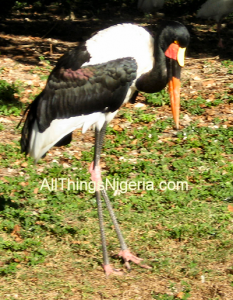Name: Saddle-Billed Stork (or Saddlebill)
Scientific Name: Ephippiorhynchus senegalensis
Local Names: Shààmuwaa (Hausa)
A saddle-billed stork’s head, neck, back, wings, and tail are iridescent black. The rest of the body and primary flight feathers being white. The massive bill is red with a black band and a yellow frontal shield (the “saddle”). The legs and feet are black with pink knees. Female storks have yellow eyes while the males have dark eyes, red feet, and a small waddle (underneath his beak), otherwise the two sexes are identical. These storks are silent since they do not have any muscles in their voice box. They rattle their bills to make noise and communicate.
Saddle-billed storks are the largest of the African storks. The saddle-billed stork is between 5 and 6 feet tall. Their wing span is up to 9 feet. They can weigh up to 20 pounds (6 kg).
Saddle-billed storks live in tropical areas of Africa and are found in a range of habitats including marches, rivers, lakes and areas of wet grasslands. They prefer wide, open spaces and avoid forested areas. A group of saddle-billed storks is called a mustering or muster.
Saddle-billed sotrks like to eat grasshoppers, frogs, fish, crabs, mollusks, lizards, and young birds.
They lay one to two eggs at a time. The incubation period is 30 to 35 days. The mating pair takes turns taking care of the young birds until they are fledged – about 70 to 100 days after hatching.
Saddle-billed stork are not endangered, although the wild population of saddle-billed storks has decreased significantly.

